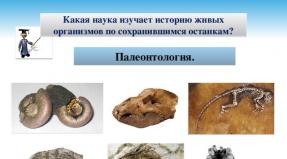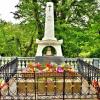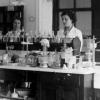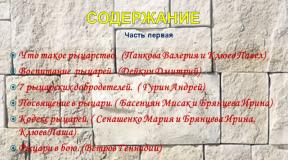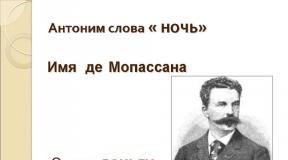Medieval knights presentation. Presentation on the topic "medieval chivalry". The winner of the tournament receives a wreath from the lady's hands
What is chivalry? (Valeria Pankova and Pavel Klyuev) Raising knights. (Deykin Dmitry) 7 knightly virtues. (Andrey Gurin) Knighting. (Basentsyan Misak and Bryantseva Irina) Code of Knights. (Senashenko Maria and Bryantseva Irina, Klyuev Pasha) Knights in battle. (Vetrov Gennady) Knight tournaments. (Kramarova Daria and Gurin Andrey) Castles of the Middle Ages. (Isaeva Marina) Did you know... (Ivanov Ilya) Part one


Who among us has not dreamed of the distant times of valiant knights, noble and devoted ladies with their fiery hearts, of the wandering heroes of Walter Scott’s novels, of the noble crusaders led by Richard the Lionheart, of the funny hidalgo Don Quixote with his faithful Sancho Panza. This period of the romantic past was not nearly so serene and glorious. We, students of grade 6 "A", decided to find out as much as possible about this and tell our friends and peers about this interesting time. Our 6a grade prepared the almanac “Knights of the Middle Ages.” In preparation for our almanac, we learned a lot of information about medieval knights. For information for the almanac, we turned to additional reference literature: encyclopedias, reference books, dictionaries. By offering the material we have collected, presented in the form of an almanac, we hope that you will like it and will open many new pages in the history of the knights of the Middle Ages and the era in which they lived...


Chivalry is a special privileged social stratum of medieval society. Traditionally, this concept is associated with the history of the countries of Western and Central Europe, where, at the dawn of the Middle Ages, essentially all secular feudal lords - warriors - belonged to knighthood. But more often this term is used in relation to medium and small feudal lords as opposed to the nobility.

In Latin, the word "mil" meant "soldier". In the early Middle Ages, this word no longer meant ordinary soldiers, but individuals who made up private armies, or those who were considered the elite. These people could afford expensive equipment. But “arming yourself” according to all the rules was not easy. The helmet, armor, and sword were expensive. A good horse was worth more than a cow. Therefore, only vassals or free people could afford to engage in military affairs. Less often, land owners armed unfree serfs, giving them money to purchase horses and weapons. Now the idea of a “mil” - a warrior - is already inextricably linked with horse riding. Throughout Western Europe, from the 7th to the 9th centuries, the idea of a professional warrior who trained in warfare for several years developed. Such people either had their own funds for a horse and weapons, or were part of the retinue of a noble lord, who also paid him for his service. The knights also differed from the rest of the inhabitants in their personal status. During the war, the knight was obliged to stand under the banner of his lord. However, the knight’s relationship with him was not built, like that of the peasants, on the principle of “master and servant.” The word "senor" meant only "elder". This word also reflected a military brotherly attitude towards his commander. It testified to a special – comradely – relationship. The Birth of Chivalry

The knightly class was a special caste of the Middle Ages, a military class. Literally, the word “knight” means “horseman,” and it is no coincidence that knights always fought on horseback. The knights became the only real force that everyone needed. Kings - to use them in the fight against other kingdoms, rebellious vassals, peasants and the church. Smaller feudal lords - counts and dukes - against the king, neighbors and peasants. Peasants - against knights who swore a vassal oath to neighboring rulers. Such disunity - everyone against everyone - was the main reason for the emergence of chivalry. This happened in the 9th-10th centuries. Chivalry has gone through different times. By centuries refers to the brilliant period of the dawn of chivalry, which was later replaced by decline. In the 10th - early 11th centuries, knights constituted a certain group of people who were united by the main thing in their life - war. Of course, there were richer and poorer knights among them, but both led the same lifestyle. They knew military affairs exceptionally well. This distinguished them from the peasants, who had to work day after day. And one can only imagine how afraid a simple peasant was of this huge warrior on horseback. In the 10th century, knights played a huge role in the fight against pagans, protecting Western Christendom.


The education of knights began at the age of 7. The young man was almost never at home; he fought in the forests with sticks, swords and spears. He went in for swimming and horse riding. At the age of 10, he entered the castle to his lord and received the rank of page or jack. The page performed the duties of a servant. He carried out various tasks for the lord and his family members. At the age of 14, the young man received the title of squire. At the castle, he looked after the horses and dogs and greeted guests.


The knights had their own traditions, fulfillment of which was their duty. Traditions required the knight to be knowledgeable in matters of religion and to know the “Seven Virtues of Knighthood.” The “seven knightly virtues” included: 1. -horse riding; 2. -fencing; 3. - skillful handling of a spear; 4. -swimming; 5. -hunting; 6. -playing checkers; 7. -composing and singing poems in honor of the lady of the heart.

The knight had to possess not only these skills, but also decent behavior at the table. Special teachings on this matter said that a knight should not stuff his mouth with both hands, wipe his nose with his hand, pick his teeth with a knife, or loosen his belt at the table.


Knighting is a symbolic ceremony of entry into knighthood. Knighting marked a transition to maturity and independence. The ceremony consisted of several stages. The day before, the future knight had to bathe in the bath, then he put on a white shirt, a scarlet surcoat, a brown chausse, golden spurs, and one of the oldest knights (or his father) girded him with a sword. In French, “gird with a sword” meant to make a knight. The girding of weapons is the main part of the ceremony. Then the initiate struck the young man with his palm on the back of the head (neck, cheek) with a brief instruction: “Be brave.” The slap on the head was called "kule". This was the only slap on the head (slap in the face) in the knight’s life that the knight could receive without returning it. The initiation ritual ended with a demonstration of the new knight's agility. Most often, knighting was carried out on religious holidays or took place on the eve of a major battle; it was preceded by a long period of training: the future knight, as a page, was trained by a noble, experienced knight or father. For example, Charlemagne in 791 solemnly girded his 13-year-old son Louis with a sword, and Louis, in 838, his 15-year-old son Charles.

For a long time anyone could be made a knight. At first, knighthood was given, according to German tradition, at the age of 13, 15, 19, but in the 13th century there was a noticeable desire to push it back to adulthood, that is, to the 21st year. Dedication most often took place on the holidays of Christmas, Easter, Ascension, Pentecost; hence the custom of a “night watch” on the eve of initiation. Each knight could knight, but most often this was done by the relatives of the dedicatee; lords, kings and emperors sought to assert this right exclusively for themselves. In the XI-XII centuries. At first, only the ritual of tying golden spurs, putting on chain mail and helmets, and a bath before vesting were added to the German custom of presenting weapons; that is, a strike with the palm of the hand on the neck, came into use later. Towards the end of the ritual, the knight jumped onto the horse without touching the stirrup, galloped and hit the mannequins mounted on the pillars with a blow from his spear. Sometimes the knights themselves turned to the church for the consecration of weapons; Thus, the Christian principle began to penetrate into the ritual.

The young squire spent the night in the temple. Here, under the dark arches, in complete silence, he knelt at one of the altars, where candles flickered in front of the image of St. George the Victorious, the patron saint of chivalry. The lights gleamed dimly on the metal of the heavy armor lying right there in front of the altar. But now the first rays of sunlight penetrated the temple through the multi-colored glass of the stained glass windows. The young man waited patiently. Finally the heavy bolts of the iron doors rattled. Now the squire had to bathe in the prepared bath - as a sign of the beginning of a new life. Then he returned to the temple again. The temple was already filled with a crowd of relatives and guests who had arrived from all the surrounding castles. The bishop began to pray. The squire humbly confessed, took communion and knelt before the bishop. He blessed his sword and handed the weapon to the future knight.

And then came the most exciting, most solemn moment. Knights, young ladies and girls dressed the young man in armor. He knelt before his lord, and he touched his shoulder three times with a sword with the words: “In the name of God, in the name of St. Michael and St. George, I make you a knight, be brave and honest.” There was a solemn feast ahead in honor of the new knight, but first he still had to show all the guests his military skill. A war horse was waiting at the exit of their temple; Without touching the stirrups, the young man jumped into the saddle and raced at full speed in front of the audience with a spear at the ready. A well-aimed blow, and the scarecrow, dressed in knightly armor, flew twenty steps to the side. The guests burst into cries of delight... Such scenes were repeated thousands, tens of thousands of times in medieval Europe. Yesterday's squire, after the initiation ceremony, became a full member of a special caste - the knightly class.


1. The Chivalric Code of Honor is mandatory for all persons of noble birth who call themselves Knights. 2. In case of violation of the Code by a Knight, his fate will be entrusted to the Suzerain, whose vassal he is, and if he deviates from the Will of the Suzerain, this person will automatically be deprived of the noble title of Knighthood, all lands and all privileges. 3.Each knight must, at the cost of his life, protect the life of his Suzerain. 4. Every knight must keep his word, because only cowardice is a shame for a Knight greater than perjury. 5. Each knight must have a Certificate confirming his noble origin. 6. Every knight must take part in Tournaments, where they show military valor, courage and great courage. 7. A knight does not dare to harm an unarmed person. 8. A knight does not dare to harm a person armed with an unequal weapon, except on the battlefield. Chivalric Code of Honor

9. A knight must be merciful and meek towards the weak, and not refuse those who ask for help. 10. A knight must be merciless to villains, enemies of him and his overlord, and to people who offend and cause evil. 11. A knight must be gallant in dealing with noble ladies. 12. If a dispute arose between the knights, or one of them insulted the other by word or deed, then the knight can demand satisfaction in a fair duel in the presence of seconds, or renunciation of his words and repentance for his actions. 13. It is prohibited to use dishonest methods at the Knight Tournament. 14. There is no thing more disgusting for a Knight than betrayal. 15. A knight cannot strike a defeated opponent (in a fair fight), as well as an opponent begging for mercy. 16. The Knight must mercilessly punish any insult to the honor of his Suzerain, the honor of the Lady (any), and his own honor. 17. Ignorance of the Code of Knightly Honor is not an mitigating circumstance for treacherous people who deviate from its rules.

This is interesting! A true knight had to treat his captive as a dear guest, even if before that they were bitter enemies for life and death. After all, who knows, the day could come when today’s captive will capture his current master. In battle, the knight had to attack the enemy in this order: 1. Enemy leader. 2.Known opponents, enemy flags and standards. 3. Noble or elite cavalry of the enemy. 4. Other cavalry. 5.Elite infantry. 6.Camp and headquarters. 7. Infantry. 8. Peasants and recruits.


Before the start of a battle, knights usually lined up in a line and less often in a deep battle formation - a “wedge”. To attack in a line, they were built in a “picket fence” - in one open line at a distance of 5-10 meters from each other. Intervals existed so that knights could freely use long spears and maneuver on horses. Behind the knights at some distance stood squires, and behind them were horse and foot archers and spearmen. The “palisade” attack was used most often in knightly battles, that is, when knightly troops clashed. A “wedge” attack is mainly against enemy troops, which included infantry. Sometimes knights entered battle not in one column, but in several. The attack columns were lined up at regular intervals.

The knights mainly attacked the enemy on horseback. Knightly cavalry has long been the main force of the medieval army. If two knightly troops met on the battlefield, the battle turned into a series of duels. Before the battle, the knight had to be given a fresh horse and new weapons. Each knight tried to choose a more knowledgeable opponent, victory over whom could bring more glory.




Knight's tournament - military competition of knights in medieval Western Europe. Presumably, tournaments began to be held in the second half of the 11th century. The birthplace of tournaments is France. The “Father” of the tournament is called Geoffroy de Preilly (first half of the 11th century). The purpose of the tournament was to demonstrate the fighting qualities of the knights who constituted the main military force of the Middle Ages. Tournaments were usually organized by the king or barons, major lords on especially solemn occasions: in honor of the marriages of kings, princes of the blood, in connection with the birth of heirs, the conclusion of peace, etc.

Knights from all over Europe gathered for tournaments. It took place publicly, with a wide gathering of feudal nobility and common people. A suitable place was chosen for the tournament near a big city, the so-called “lists”. The stadium had a quadrangular shape and was surrounded by a wooden barrier. Benches, boxes, and tents for spectators were erected nearby. The course of the tournament was regulated by a special code, the observance of which was monitored by heralds; they announced the names of the participants and the conditions of the tournament. The conditions (rules) were different. In the 13th century a knight had no right to participate in the tournament unless he could prove that four generations of his ancestors were freemen. Over time, coats of arms began to be checked at the tournament, and special tournament books and tournament lists were introduced. Usually the tournament began with a duel between knights, usually newly knighted, the so-called “jute.”

Such a duel was called a tiost duel with spears. Then the main competition was held, simulating a battle between two detachments, formed by “nations” or regions. The victors took their opponents prisoner, took away weapons and horses, and forced the vanquished to pay a ransom. From the 13th century the tournament was often accompanied by severe injuries and even death of participants. The church prohibited tournaments and the burial of the dead, but the custom turned out to be ineradicable. At the end of the tournament, the names of the winners were announced and awards were distributed. The winner of the tournament had the right to choose the queen of the tournament. Tournaments stopped in the 16th century, when knightly cavalry lost its importance and was supplanted by infantry riflemen recruited from townspeople and peasants.


The appearance of castles, fortified dwellings of feudal lords, dates back to the reign of the Carolingians, the royal dynasty of the Franks. The most famous representative of the dynasty was the legendary Charlemagne. The most ancient castles were a fortified dwelling of feudal lords on the top of a cliff, surrounded by a high and thick wall made of stone blocks. Built from the same stone blocks, the house was a well-fortified fortress. Now I will tell you what is inside the castle. The huge hall, dark and therefore gloomy, was illuminated by the fire of the fireplace - also huge, from one window to another. There is a large table in the middle. Golden flames sparkle on gold and silver vessels and utensils. There are herbs on the stone floor, and this makes the room smell like a summer meadow. This was the main room of the castle.

You can get here from the top of the stone staircase, passing through an extensive corridor that stretches along the facade of the building. This is a bright gallery with many windows. There are few amenities in the hall. However, the desire for expediency did not cancel the desire to decorate your home: the floor in the hall, although stone, was multi-colored. The slabs alternate correctly with each other and form a unique pattern. The gloominess of the room is softened by the whitewashed walls, sometimes painted with paints, hung with deer antlers, shields, and spears. There are also frescoes, the colors on them are monotonous, but even they enliven the walls.


1. Among the knights, killing an unarmed enemy was considered a special shame. Lancelot, a knight without fear and reproach, could not forgive himself for one “mistake”: once, in the heat of battle, he killed two unarmed knights and noticed this when, alas, it was too late to correct anything. He felt that he was not asking for such a grave sin, and made a promise to make a walking pilgrimage in only a shirt to atone for his sin. 2. Horse armor included a "plate muzzle" for the horse's head, a "breastplate" or breastplate, and "croup armor" to protect the sides of the animal. The rider's armor consists of several parts. A lightweight helmet was worn with a high protective device for the chin or throat and lower part of the face. Knights of Central and Western Europe had such a complete set of armor at the end of the 15th century. The knights' horses were covered with blankets. They carried the rider's weapons, but perhaps leather or padded fabric protected the horse from the weather.

3. Two-handed sword At the end of knightly times (in the 14th century), in addition to the usual sword and spear, other types of weapons appeared, for example, a huge sword - up to 2 m long. It could only be held with two hands, which is why it was called two-handed. There was a sword and “one and a half hands”. Fingers, axes, and reeds, which were intended for washing metal armor and helmets, became widespread. However, these types of weapons were used mainly not by knights, but by hired regular troops and infantry. 4. Chain mail Already by the middle of the 12th century. all the knights dressed in chain mail. In the engravings of that time you can see that steel chain mail covered the warrior from head to toe: parts of them included leg guards, gloves, and hoods. This flexible steel garment was worn over a leather or quilted undershirt to protect against bruises, and they could be very sensitive, even if a sword or battle ax did not cut through the steel rings. On top of the chain mail they put on a linen tunic, which protected it from exposure to moisture and sunlight. It was sewn from expensive fabric and decorated with embroidery - usually with images of the family knight's coat of arms. Contemporaries claimed that it was as easy and comfortable to move in it as in ordinary clothes.


Richard the Lionheart (1157 – 1199). The English king Richard was the first to receive the nickname Lionheart for his fierce courage. He became especially famous during the 3rd Crusade. Reaching Palestine by ship, Richard captured the island of Cyprus. In 1191, moving towards Jerusalem at the head of 100 thousand crusaders, he defeated Saladin's army of two thousand. Richard appeared on the battlefield wherever it was difficult and cut into the ranks of the enemy. Saladin's army fled, but the crusaders hesitated and missed the opportunity to take Jerusalem. When the 1st Crusade began, neither sword, nor famine, nor plague stopped the crusaders. In 1099 they took Jerusalem, exterminating its inhabitants. The Crusader Kingdom of Jerusalem arose in Palestine. But less than a hundred years passed before Sultan Salah ad-Din (Saladin) took possession of Jerusalem. In response to the loss of Jerusalem, the 3rd campaign began, in which Richard became famous. Richard 1st owned considerable lands in France. King Philip II of France (a fellow Crusade comrade) occupied part of these lands. In response, Richard I started a war with Philip II. During the siege of one of the castles, Richard was hit by an arrow and died.


King Arthur is presented as one of the nine most worthy heroes of the Middle Ages. Young Arthur, according to legend, became king after he obtained the magic sword Excalibur - the sword of the mistress of the wonderful lake. King Arthur became famous for his wisdom, courage, and honor. Arthur put an end to civil strife, united the English lands and drove out the Saxon conquerors. Together with his wife Guinevere, he ruled from a beautiful city called Camelot. At his court in Camelot, he gathered the best knights so that everyone felt equal, the king and his knights sat at a round table (it was from these depths of time that the expression “at the round table” came - when everyone’s opinion is equally worthy of attention). After Arthur's death, a mysterious hand rose from the waters of the lake and took the sword Excalibur.


The cult of the Beautiful Lady originated in Southern France, in the county of Provence, and from there spread throughout Western Europe. Provence was rich, enlightened, trade and crafts flourished here, and literature developed. And the position of the lady in Provence was also incomparably higher than in any other counties, duchies and kingdoms. She could manage her property herself and was absolutely equal in all rights with a man. The cult of the Beautiful Lady began with the special worship of the Virgin Mary. She was called the meek Lady of Heaven, the heavenly queen, her images on icons began to be clothed in precious clothes and crowned. Such worship of the Mother of God, in turn, exalted the earthly woman. The ideal knight is now honest, smart, modest, generous, brave, polite.

Serving the Beautiful Lady became a universal custom; no one from the knightly class could evade it. After being knighted, everyone had to choose a lady for himself, noble or ignorant, married or not, and obtain permission from her to serve her. It is usually not easy to achieve the favor of the chosen lady. It was necessary to perform a number of feats for the glory of the chosen one, win loud victories in tournaments, and only when, in her opinion, there were enough feats, the time came for a special ceremony: the lady accepted the admirer as her knight. If the lady allows him to serve herself, the knight becomes heard.

The cult of the Beautiful Lady in the fine arts in the Middle Ages. In addition to poetry, the image of the Beautiful Lady was reflected in Medieval fine art, such as tapestries. A tapestry or trellis is a woven fabric with a pattern that was hung on the walls in rich, noble houses. The tapestry was most often a wedding gift. One of the most common subjects in the Middle Ages was the image of the Beautiful Garden. In the center of the composition, as a rule, there was an image of a Beautiful Lady and a Unicorn. Along the edges were images of birds and animals. An organ or fountain could also be depicted. The tapestry field was covered with herbs and flowers. For modern people, this picture is not entirely clear. But for a man of the Middle Ages, every detail of the tapestry had its own obvious meaning.

The Virgo and Unicorn personified purity and innocence. The unicorn was also a symbol of Christ - the Only Begotten Son of God. The organ was an attribute of one of the seven divine arts - music. The fountain was a symbol of Christianity - the source of Faith. The tree with fruits was a symbol of the Tree of Life - the paradise Tree of the knowledge of good and evil. The lion is a symbol of power and might. The peacock reflected the theme of Paradise, as it was considered the Bird of Paradise. The dog is a symbol of fidelity. Rabbits symbolized childbirth. Deer is a symbol of nobility. Even a simple dandelion had hidden symbolism, its bitter juice symbolized the bitterness of the Suffering of Christ, and forget-me-nots, according to legend, grew in the place where the Tears of the Mother of God fell.



Cervantes, Miguel de Saavedra () - famous Spanish writer. In his youth he served in Rome, then took part in the naval battle with the Turks at Lepanto; Later he was captured by corsairs and sold into slavery in Algeria, where he stayed for 5 years. Cervantes subsequently received the position of tax collector and then became a private attorney, devoting most of his time to literature. Cervantes began his literary career with the shepherd's novel Galatea. Later he moved on to dramatic works and wrote a number of comedies and tragedies. In 1605, Cervantes published the novel Don Quixote, which brought him worldwide fame.

Cervantes, a Spanish writer, in his novel Don Quixote described how a noble nobleman, after reading chivalric novels, decided to become a knight errant. Perform feats, protect the weak, punish villains. Don Quixote is accompanied by the cheerful peasant Sancho Panza. Alas, in the 16th century, the chivalric virtues sung in old novels were no longer needed by anyone. Profit is the main thing for people. But Don Quixote does not understand this. And after his exploits, he is subject to ridicule and even beatings. And the evil giants, the crowd of which he clearly sees and bravely attacks, turn out to be windmills. However, Don Quixote again and again raises his sword against evil forces. Cervantes's novel is a book about a book, literature that continues in life, and life that becomes literature. What is the mystery of Don Quixote, where is the secret of his ageless relevance, which conquers space and time, hidden? I think Cervantes paradoxically managed to capture and capture in this image the original duality of human culture, which is based on the contradiction between the real and the ideal, between sleep and reality, between what a person wants to do and what he is forced to do. The fictional world of literature in which Don Quixote lives often does not coincide with real life and at the same time incredibly clarifies its essence. It turns out to be a kind of game of life with culture, in which action implies a plot, and the plot leads to action.


Knight I imagine a knight on a white horse and the reflection of sparkling armor. Crowned with glory in battle and in fire, the gaze glows with fearlessness. And his whole appearance glows with courage, In him is firmness and strength and age-old honor. Our knight does not know treason or fear, he will destroy the enemy, defending the country. He will not bend his knee to anyone except his beloved lady. I want our men to be worthy of your valor! Isaeva Marina and Kramarova Dasha * * * Brave knights, Brave and important heroes. The knights can handle everything, they win both here and there! Lemeshko Maria * * * The knight will always win, He will achieve his goal. The knight is the bravest. It's better not to exist! Pankova Valeria * * * The knight loves to fight, help and protect. Knight, he is handsome, smart! Simply the best! Senashenko Maria POEMS

Knight - hero Brave, kind, brave Defends, wins Pakhomova Ksenia Knight - defender Brave, courageous, smart Defends, wins, Wins the hearts of ladies. Vetrov Gennady and Basentsyan Misak Knight - courage Brave, brave, courageous Not afraid, fights Protects children and women Deikin Dmitry Knight - victory Valiant, brave, courageous Wins, fights A brave knight entered the field, defeated everyone and was satisfied. Klyuev Pavel SINKWAIN


The herald is the judge at the tournament. A vassal is a feudal lord who received land from a larger landowner, a lord, and swore an oath of allegiance to this lord. Plate is iron or steel armor worn to protect against bladed weapons. The stadium is the place where the tournament is held, usually rectangular in shape. Knight - (German Ritter, original meaning - horseman), in Western and Central Europe in the Middle Ages, a feudal lord, a heavily armed equestrian warrior. In the knightly environment, concepts of nobility, honor, and duty were developed that idealized chivalry. Title - an honorary title (for example, count, duke), hereditary or assigned to individuals to emphasize their special, privileged position and requiring a corresponding title (for example, lordship, highness).

The tournament is a competition of knights. Suzerain is a king, a major feudal lord, any superior feudal lord in relation to a lower one, the owner of the land. Troubadour - storyteller, singer, musician in France. Fresco - painting with water paints on freshly applied, damp plaster. Paints are diluted with clean or lime water. When dry, the plaster forms a film that makes the fresco durable.



1. Dictionary of a young historian: General history. - M.: “Pedagogy - Press”, Lukenbein M. Knights. - M.: “AST”, Mikel P. Knights and castles. - M.: “Olma - Press”, Encyclopedia for children: vol.1 - M.: “Avanta +”, Encyclopedia for children A and F. - M.: “A and F for children”, Everything about everything. Knights. Tournaments. Weapon. - M.: “Astrel”, Everything about everything. Famous people. – M.: “Planet of Childhood”, 2001.

Presentation of the project “Knights of the Middle Ages”
“My double shell shines brighter than the day.
My sword is Guidon’s gift, because we are related.
Not giving way to me is a bad joke.
Everyone is running away, their armor clanking!”
You probably guessed that we are talking about chivalry. Our group presents the project “Knights of the Middle Ages”.
The goal of our project:
To study the lifestyle of knighthood as one of the dominant classes of medieval Europe.
Who are knights?
In the warlike, turbulent times of the Middle Ages, the role of the class of “those who fight”—knighthood—was extremely important. Anyone who had enough money to buy a war horse, weapons and armor could become a knight. A complete set of the simplest knightly weapons was incredibly expensive - you had to pay at least 45 cows for it! Not every peasant village had such a herd. Only the son of a knight could become a knight. He had been preparing for this since early childhood and had to undergo a rite of passage.
Armament of knights.
Knights were professional soldiers, constantly ready to repel an attack or answer the call of their lord to join his army. The spear and sword became the basis of knightly weapons. Knights did not use bows: these were the weapons of commoners.
The spear was carved from wood and equipped with an iron tip. In the hands of a knight running at full gallop, it was a formidable weapon. The spear of the attacking knight usually broke, and he went into the next battle with a new one.
After a successful attack, the knight dismounted and the battle continued with swords.
The swords were different: from short to huge ones that could only be lifted with both hands. A good sword did not bend or break, and was so sharp that with one swing it could cut a bale of wool.
The sword was not just a weapon. For the knight it was a shrine. The sword had its own name,
The sword was necessarily consecrated in the church. Swords were usually passed down from father to son.
In addition to shock weapons, the knights, of course, also had protective weapons - armor. Otherwise, not a single knight would survive even his first battle.
In the early Middle Ages, knights often used leather shirts on which metal rings or plates were sewn, placing them so that they partially overlapped each other, like fish scales. In the 10th century, chain mail appeared - a long robe reaching to the knees, woven from metal rings. The knight wore a chainmail hood or a forged iron helmet of a pointed shape with plates to protect the cheeks and nose. Such armor was relatively light and flexible, protected well from arrows, but could not withstand the blow of a spear or sword. Therefore, an important element of armor was the shield.
Shields were made of wood or thick leather.
By the end of the 13th century. chain mail is practically going out of use. They are being replaced by armor - armor made of forged iron plates. They protected the knight's entire body: from head to toes.
Where did the knights live?
Knights lived in castles. This was the name of a well-fortified structure adapted to a long siege. There, the knight and the population of the surrounding villages under his control could hide from enemies during military clashes or, for example, Norman raids. By the way, castles first appeared in Europe precisely in the 9th-10th centuries, in the “era.
They were usually built on hills.
At the top of the hill was the main building of the castle, the home of its owner.
Small loophole windows in the thick walls of the castle let in little light, so the interior was usually in twilight. These premises themselves were quite large halls, from which the masters' bedrooms, weapon rooms and kitchen area were separated by partitions. There was no particular comfort: its inhabitants considered the main advantage of the castle not convenience, but reliability, the ability to withstand both an assault and a long siege.
Over time, the design of locks became more complicated. They began to build them from stone. From the beginning of the 11th century. castles turned into impregnable stone fortresses, behind whose walls the feudal lord could feel safe.
The real holidays, for which the knights prepared for a long time and for which they came from the most remote places, were periodically held competitions in the art of war - tournaments. Many spectators, including ladies, gathered for the tournament. They watched the unfolding battle with interest. Their opinions were taken into account when awarding prizes to the winners. The area in which the tournament took place was full of banners of participants, shields depicting their coats of arms, and elegant attire of spectators. The heralds announced the rules of the tournament, the participants took an oath to strictly follow them, and the competition began. It was usually opened by a group battle, followed by several duels between knights. The winners were awarded prizes, they were given honors, glory, the respect of knights and the admiration of beautiful ladies awaited them. In addition, the rules of some tournaments allowed the winner to take the weapons and armor of the vanquished as a trophy, and sometimes demand a ransom for him, as if he were captured in a real battle.
By the 13th century. It was everywhere forbidden to use military weapons in tournaments: they fought with dull swords and spears from which the iron tips had been removed. Tournament participants died less frequently, but fractures and other injuries remained common.
Knighting.
Each knight had the right to initiate any person into knighthood with a blow of the sword flat on the shoulder, but they tried to carry out the initiation rite - the accolade - with great solemnity and according to the established ritual. On the eve, the person preparing for initiation had to bathe, put on a white shirt, a scarlet surcoat, a brown chausse, golden spurs, one of the oldest knights girded him with a sword, which constituted the main part of the ceremony. After this, the dedicator struck the young man with his palm on the back of the head, or neck, cheek with the instruction: “Be brave” - the only blow in life that the knight could not return. This was followed by a demonstration of the knight's strength and dexterity.
The knighthood finally came into force after a blow with a flat sword on the shoulder, accompanied by the words of the dedicator: “In the name of God, St. Michael and St. George, I make you a knight. Be pious, courageous and noble."
Having become a knight, a person was obliged to strictly observe the code of knightly honor. The knight usually dedicated his exploits to the Lady of the Heart. The knight tried with all his might to win the affection of the Beautiful Lady.
Knight's coat of arms.
Each knightly family had its own coat of arms. His image was initially placed on the knight’s shield, and subsequently on all items belonging to the feudal lord, from clothing to furniture and tableware. By the coat of arms it was possible to determine the antiquity and degree of nobility of the family, as well as sometimes for what merits the coat of arms (or its ancestor) was knighted.
(demonstration of the coat of arms)
Thus
Knights formed the military class in medieval Western Europe. The main occupation of a knight is war. This largely determined the code of honor of the knight, designed for a warrior capable of defending goodness and justice with a sword in his hands. Knights lived in castles, always ready to repel the enemy. The knight spent his peacetime in military pursuits. In this regard, it is not surprising that the knight’s favorite pastimes are tournaments and hunting, one way or another connected with the art of war.
Slide 1
Slide description:
Slide 2
Slide description:
Slide 3
Slide description:
Slide 4
Slide description:
Slide 5
Slide description:
Slide 6
Slide description:
Slide 7
Slide description:
Slide 8
Slide description:
Slide 9
Slide description:
Slide 10
Slide description:
Slide 11
Slide description:
Slide 12
Slide description:
Slide 13
Slide description:
Slide 14
Slide description:
Slide 15
Slide description:
Slide 16
Slide description:
Slide 17
Slide description:
Slide 18
Slide description:
Slide 19
Slide description:
Slide 20
Slide description:
Slide 21
Slide description:
Slide 22
Slide description:
Slide 23
Slide description:
Slide 24
Slide description:
Slide 25
Slide description: Slide description:
When we mention the word “knight,” our imagination automatically draws an image of a noble, muscular, pious man from the Middle Ages. Indeed, the word “knight” came to us from that era. But the image the image paints for us is not very accurate. As was said above, today the word noble is synonymous with the word knight. But during the emergence of knights, the concept of warrior was synonymous. It also characterized his behavior both with the lady and with the enemy. In general, the fact of the appearance of knights in such a dark era of history can be called very surprising. They can easily be called the prototype of modern athletes. They resolved their disputes by fair fights and tournaments, and not by bloodthirsty methods. The traits that characterized belonging to the knightly fraternity were the following: the pursuit of glory, courage, armor emphasizing his beauty and, naturally, strength. But all these traits required constant proof, forcing the knights to perform heroic deeds, demonstrating their best qualities. There was also a certain set of rules, or, more precisely, obligations inherent in the knighthood. The top line of these obligations was occupied by service to the sovereign, followed by the one who ordained the knight to this rank, and then the sets of these rules obligated him to help the weak (orphans, widows). In battle, the knight’s attitude towards his opponent was very indicative, the knight was obliged to honor his enemy and if he was weaker, he had to provide equal chances of battle, because victory over the weak did not bring a drop of glory, but only shame. Weapons and horses were very important elements in knightly life. Very often, each of these elements bore its own name. Also a very important feature of the knight was the need for a lady of his heart. Although echoes of history have reached us, which we try to quote, calling good deeds knightly deeds, we should not get carried away. After all, although the knights had good, even demonstrative relationships with representatives of the fairer sex, their relationships were exclusively premarital, because such concepts as marriage and knighthood are mutually exclusive things. This in no way destroys the stereotype of “knightly behavior” because today nothing prohibits starting a family. When we mention the word “knight,” our imagination automatically draws an image of a noble, muscular, pious man from the Middle Ages. Indeed, the word “knight” came to us from that era. But the image the image paints for us is not very accurate. As was said above, today the word noble is synonymous with the word knight. But during the emergence of knights, the concept of warrior was synonymous. It also characterized his behavior both with the lady and with the enemy. In general, the fact of the appearance of knights in such a dark era of history can be called very surprising. They can easily be called the prototype of modern athletes. They resolved their disputes by fair fights and tournaments, and not by bloodthirsty methods. The traits that characterized belonging to the knightly fraternity were the following: the pursuit of glory, courage, armor emphasizing his beauty and, naturally, strength. But all these traits required constant proof, forcing the knights to perform heroic deeds, demonstrating their best qualities. There was also a certain set of rules, or, more precisely, obligations inherent in the knighthood. The top line of these obligations was occupied by service to the sovereign, followed by the one who ordained the knight to this rank, and then the sets of these rules obligated him to help the weak (orphans, widows). In battle, the knight’s attitude towards his opponent was very indicative, the knight was obliged to honor his enemy and if he was weaker, he had to provide equal chances of battle, because victory over the weak did not bring a drop of glory, but only shame. Weapons and horses were very important elements in knightly life. Very often, each of these elements bore its own name. Also a very important feature of the knight was the need for a lady of his heart. Although echoes of history have reached us, which we try to quote, calling good deeds knightly deeds, we should not get carried away. After all, although the knights had good, even demonstrative relationships with representatives of the fairer sex, their relationships were exclusively premarital, because such concepts as marriage and knighthood are mutually exclusive things. This in no way destroys the stereotype of “knightly behavior” because today nothing prohibits starting a family.
Slide 28
Slide description:
KNIGHTS
MIDDLE AGES
Blessed by His Majesty's right hand is this sword to serve as the protection of the church, widows, orphans and all His subjects...

In the 10th-15th centuries in Europe, knights enjoyed honor and respect.
Armored warriors on war horses were a formidable, swift force that was not easy to stop on the battlefield. In horse battle, protected by chain mail or heavy armor, they fought with three-meter spears, and on foot - with long heavy swords, a mace or a battle axe.

Who are knights?
Knight (from German "reitar" - horseman) - an equestrian warrior belonging to the upper class.
Over time, all lords began to be called knights, since their main duty was to perform mounted military service.

Over time, more and more, the success of the battle was decided not by brave lone warriors, but by infantrymen, especially archers.
By the beginning of the 16th century, the word “knight” itself meant just a title.



Medieval castle Hochosterwitz – In the Austrian lands

Medieval Glamis Castle in Scotland

Evolution of the knight's castle
1st - 9th century
2 - Norman castle
11th century with a pedestrian bridge to the main tower
3 – type of castle tower made of brick, 10th century
4 – Anglo-Romanesque castle, late 11th century
5 – castle on the island, XIII – XIV centuries

1 – barbican
2- dam (dam)
3- palisade
4 - moat with water
5 - watch tower
6 - lifting
7 - lateral move
9- external
10 – lifting
11 - donjon
12 - internal
13 - distant
14 - guardhouse
15 - loophole
16 - corner
17 – side tower
18 - bastion
19 – jagged parapet
20 – chapel
21 - toilet
Scheme of a medieval fortress-castle

Scheme of entrance to the castle:
2 - gallery on the wall,
3 - drawbridge,
4 - lattice (gerases )

Fortress towers were of great importance in the defense of the castle, initially square in plan and then round, which contributed to a better firing radius.
Later, towers with loopholes and machismo – galleries protruding above the walls of the tower with hatches in the floor



Donjon –
feudal lord's dwelling
Donjon - tower house of rectangular or polyhedral shape.
Occupied a dominant position in the castle.





The path to knighthood.
At the age of 21, the young man was knighted at a special ceremony.
At the ceremony, the squire knelt before the lord, sometimes the king himself, and the latter struck him three times flat on the shoulder with a sword.
The new knight was then given a sword and spurs.
On this day, feasts and tournaments were certainly held, at which the initiate could show his skills.

Squires
The squire looked after the horses.
He met guests, and carried the knight’s armor on the campaign.
On the battlefield, he was close to the knight, ready at any moment to give him a spare weapon.






Knight spirit
Knights adhered to a special behavior that came to be called chivalry.
At the tournament
The knight was brave and furious on the battlefield, but in ordinary life he behaved courteously and kindly.
At the tournament, rivals rushed towards each other at great speed.
Knight's spears were measured: their length had to be the same.
The knight showed special attention to those who were higher in rank or position.
The knight defended everything that was connected with the Christian faith.



Victory and defeat in a knight's tournament
The main thing is victory, not participation. (motto of the knights)
The winner gets the horse and all the equipment. The winner has the right to capture his opponent and demand a ransom.



Knight and his lady
The winner of the tournament receives a wreath from the lady's hands.
The clothes of the lady and the knight had to be the same colors.


XIII century
XIV – XV centuries

In the 13th century, metal armor appeared.
They weighed over forty kilograms.

Knight's helmet with removable visor.
The warrior’s neck and shoulders were protected by chain mail made of metal rings, attached to a helmet.

An infantryman's ax or halberd, and a mace.
The helmet, called the "great helm", was made from a single piece of metal around 1370.
This armor of the late 15th century. testify to the powerful physique of a medieval knight.

Knight's horses
Ceremonial armor
Horses received protection not for the sake of beauty - often knights hit them.

Symbolism on shields
In the 12th century, knights began to use brightly colored shields.
Over time, the symbols on them became an integral part of knightly coats of arms.
The coat of arms consisted of two elements: a field and figures.
The knight's coat of arms was painted or embroidered on all his equipment.
The symbols on the coat of arms had a special meaning.
Coats of arms were created according to the rules accepted in a given country.
It was allowed to use colors of three groups: metals, enamel, furs.
German knight of the 13th century.

"courage", "passion"
"greatness, beauty, clarity"
"purity and modesty", "nobility"
"wealth, strength, loyalty", "nobility"
Coat of arms of Richard the Lionheart

1. A LION - courage, strength and generosity;
2. CRANE- vigilance and caution;
3. LILY- prosperity and success;
4. UNORG- invincibility,
5. GRIF- fearlessness and ferocity;
6. CAT- independence;
7. WOLF- anger, greed;
8. BOAR- fearlessness;
9. ROOSTER- belligerence;
10. PEACOCK- beauty;

Chivalric morality
The main duties of a knight:
- be brave and faithful
- to be loyal to one's overlord
- defend the faith and the Church
- patronize widows and orphans


The knights also had their own code of honor
They were supposed to:
- protect knightly dignity,
- speak the truth and keep your word,
- maintain purity of morals,
- be generous
- protect the weak
- be gallant with women and courteous with everyone else,
- fight against evil and defend good.

Feast in the knight's castle
On a table in the 11th century :
Tablecloth, metal cups, table knives (daggers), fruits, dried fruits, beer, bread, meat, fish, nuts, turnips, olive oil, black pepper.
Plates made of tin and wood appeared in the 14th – 15th centuries.
In the 8th - 9th centuries, the role of plates was played by special recesses in an oak table.
The food was taken from the middle of the table with the fingers and placed on a piece of bread.

Medieval dining room in the castle .

Read also...
- Artistic culture of the period of “stagnation” Presentations on the topic of culture of stagnation in the USSR
- Do you know how a message about the chemical element francium
- Development of a lesson on the history of Russia: “Culture and spiritual climate in the era of “stagnation” Soviet cultures during the years of stagnation presentation
- Presentation on the topic "Medieval chivalry"


